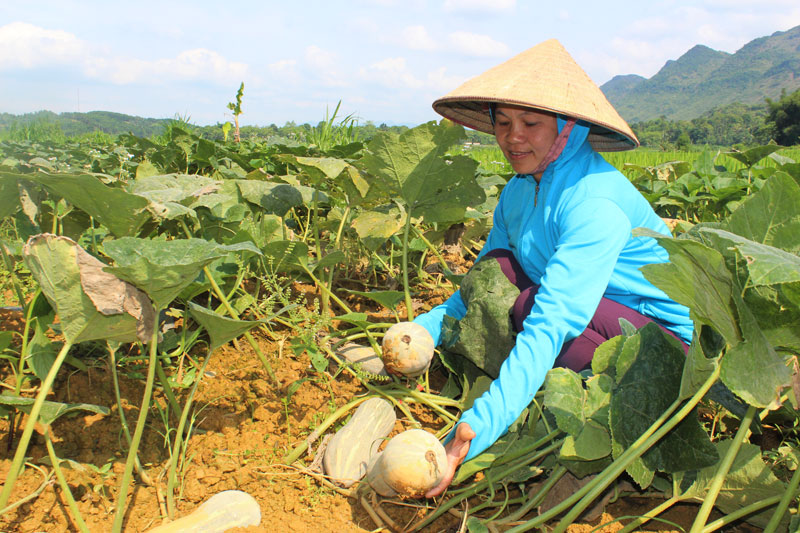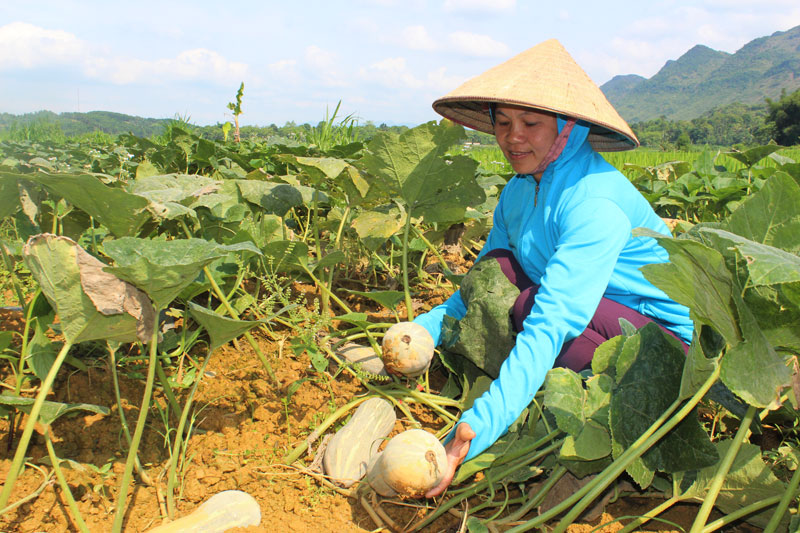
(HBO) - Households in Bai Von hamlet, Dinh Cu commune (Lac Son district, Hoa Binh province) have cooperated with enterprises to pilot the model of pumpkin cultivation for seeds. The model initially proved effective as it brings higher profits than other traditional crops.

Cultivation area of
pumpkin-for-seeds of Mrs. Bui Thi Tinh’s family in Bai Von hamlet, Dinh Cu commune, Lac Son
district, brings high economic efficiency.
Specifically, if the yield on the area of
1,000 m2 is 17 kg of seeds, the company will buy at 880,000 VND/kg, higher than
the average of 840,000 VND/kg.
We visited Mrs. Bui Thi Vinh’s family in
Bai Von hamlet at the harvest season of pumpkins. Compared to the two previous
crops, Tinh’s family had a bumper crop. Tinh said her family started developing
the model at the beginning of 2017 with a cultivation area of only 800m2. Thanks
to the support and assistance of the company, after about 80 days, her family’s
pumpkin garden was harvested, bringing profit of about 8 million VND.
She said her family decided to transfer more
than 3,000 sq.m of agricultural land to the cultivation of pumpkin-for-seeds.
After the last winter-spring crop, Tinh’s family collected 5,000 pumpkins. Each
70 fresh pumpkins offer 1kg of dried seeds, which is at price of 840,000
VND/kg. The family collected about 50 million VND after deducting all costs.
Tinh added that the model is very suitable
for soil and climate conditions in the locality.
This plant is healthy, easy to care for
and suffers fewer pests. In addition, it only takes famers 80 days to harvest from
the date of seedling. Pumpkin should be planted on high and good drainage areas.
Currently, the area of pumpkin-for-seeds in
Bai Von hamlet has been expanded to nearly 1 ha with 5 households joining the
model. In order to achieve the highest efficiency, the involved households
regularly share experience and growing techniquesto support each other. /.
According to data from the Hoa Binh Provincial Party Committee, the industrial production index for the first six months of 2025 is estimated to have increased by 20% compared to the same period last year. This marks the highest year-on-year growth rate for this period since 2020.
In the first six months of 2025, Hoa Binh province’s export turnover was estimated at 1.145 billion USD, marking an 18.11% increase compared to the same period in 2024. Import turnover was estimated at $ 804 million, a 17.15% increase, which helped the province maintain a positive trade balance.
The lives of the ethnic minority farmers in Tan Lac district have gradually improved thanks to the new directions in agricultural production. This is a testament to the collective strength fostered through the professional associations and groups implemented by various levels of the district’s Farmers’ Union.
With the motto the "product quality comes first,” after nearly one year of establishment and operation, Muong village’s Clean Food Agricultural and Commercial Cooperative, located in Cau Hamlet, Hung Son Commune (Kim Boi district), has launched reputable, high-quality agricultural products to the market that are well-received by consumers. The products such as Muong village’s pork sausage, salt-cured chicken, and salt-cured pork hocks have gradually carved out a place in the market and they are on the path to obtaining the OCOP certification.
In the past, the phrase "bumper harvest, rock-bottom prices" was a familiar refrain for Vietnamese farmers engaged in fragmented, small-scale agriculture. But today, a new spirit is emerging across rural areas of Hoa Binh province - one of collaboration, organisation, and collective economic models that provide a stable foundation for production.
Maintaining growing area codes and packing facility codes in accordance with regulations is a mandatory requirement for agricultural products to be eligible for export. Recently, the Department of Agriculture and Environment of Hoa Binh province has intensified technical supervision of designated farming areas and packing facilities to safeguard the "green passport" that enables its products to access international markets.



